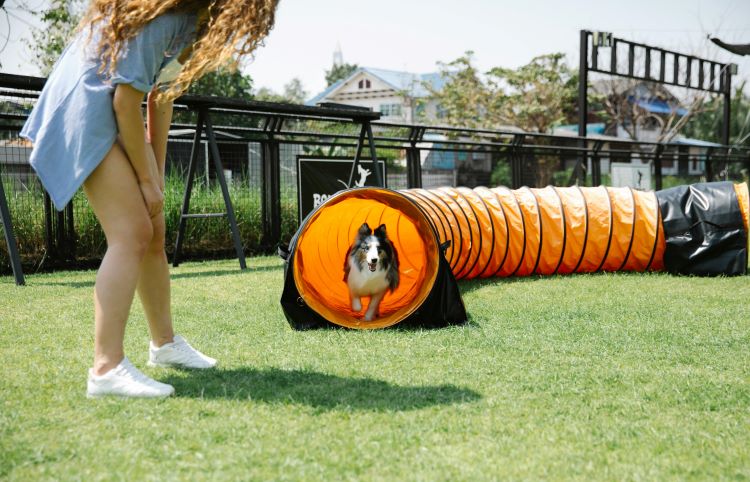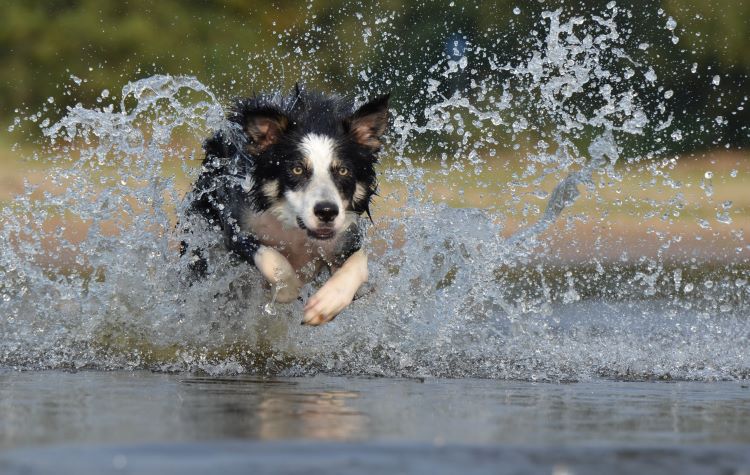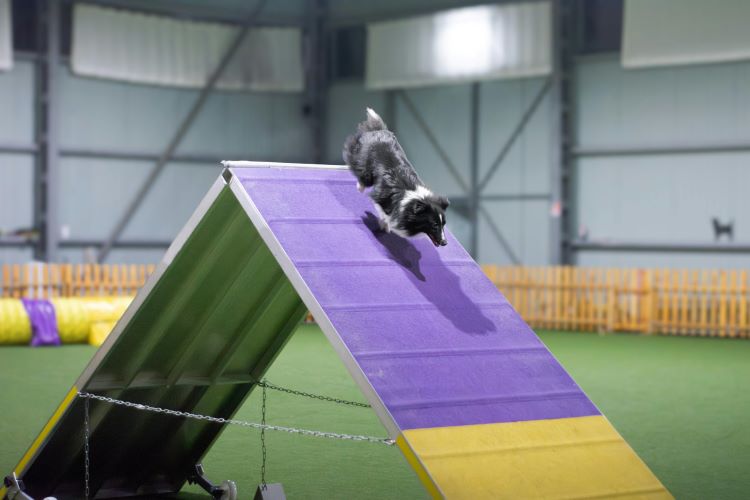Ready to help treat your pet to a healthy life?
How to Make a Dog Agility Course at Home
By : Kelli Rascoe & Trupanion Staff | Updated Sep 13, 2024

If you’re looking for a new activity to do with your dog, consider creating your own DIY dog agility course! Whether you’re a new pet owner or have a multi-dog household, this interactive activity is a great way to bond with your best friend. Dog agility has become a popular sport in recent decades and could be new way for your dog to get some exercise.
While certain dog breeds are more closely associated with agility training (more on this below), the truth is that just about any breed can get into it. This is an activity that can be beneficial for pups of all ages, shapes, and sizes. Dog agility courses themselves come in a wide array of shapes, sizes, and difficulty levels, and many pet owners can make them right at home (inside or outside, depending on the space).
What is dog agility training?
If you've never heard of canine agility before, it may seem like just an elaborate form of play. In reality, it's so much more. Dog agility is a canine sport that centers around a dog navigating an obstacle course, often with speed as the focus or a time limit. And while there are competitive circuits, canine agility training doesn't have to be for professional purposes. Many pet owners set up DIY dog agility courses for just a fun form of exercise at home.
Benefits
Daily exercise is beneficial for your dog’s overall health. You may find that your dog wants a new, interesting challenge as they age. A sport like dog agility may give you and your best friend a chance to learn and grow together. While some pet owners go on to do agility competitions with their dog, the main goals should always be providing a source of fun and exercise for your pet.
Currently struggling with a pet who doesn't get enough exercise or is acting out due to boredom and understimulation? A switch in your routine and a new activity might be just what your best friend needs for some motivation, and creating your own DIY dog agility course is a fun and cost-effective way to do so.
Dog breeds that do well with agility training
Every dog breed should have the opportunity to train and learn new skills. In fact, every dog is different and it may take time to learn agility and that is okay. Your dog’s age or breed may also play a factor in the way they learn. Nevertheless, certain dog breeds are naturally more energetic and may take to agility training faster. Common breeds seen at agility events include herding dogs and those who have natural athleticism:
- Border Collie: A herding breed renowned for their problem-solving intelligence and quick speed, Border Collies are often top performers in agility competitions.
- Australian Shepherd: Another herding dog breed, Australian Shepherds are smart and physically capable, thriving when facing athletic challenges.
- Australian Cattle Dog: With their stamina and intelligence, Australian Cattle Dogs are well-suited for competitive events that channel their own herding nature.
- Shetland Sheepdog: Often called "Shelties," these smaller herding dogs are quick learners and highly agile.
- Papillon: Despite their petite stature, Papillons are exceptionally agile and excel in smaller-sized courses with their quick movements and intelligence.
- Jack Russell Terrier: Known for their boundless energy and agility, Jack Russells are natural athletes.
- Border Terrier: Agile and intelligent, this small British dog breed enjoy agility challenges and excel in courses that test their speed and ability to navigate obstacles.
- Golden Retriever: Though primarily known for their friendly nature, Golden Retrievers are also capable agility dogs, combining athleticism with a strong desire to please their handlers.
- Labrador Retriever: Like Goldens, Labs are versatile and agile, enjoying the challenges of agility training.
- Belgian Malinois: Highly energetic and driven, Belgian Malinois dogs excel in agility training and are often used in various dog sports due to their athleticism and intelligence.

How to make a dog agility course at home
Creating your own DIY dog agility course may be easier than you think! Even small spaces can fit a simple agility course. Here are some quick tips to help get you started:
- If you're handy, you can create a lot of agility equipment with PVC pipes.
- Add features like jumps, footwork ladders, and weave poles to customize your dog course.
- Dog agility courses can be unique and different, so cater to your pet’s individual needs and personality.
- Start small and don’t overwhelm yourself. Start with simple features like a jump or a weave pole.
- Plan and design your course first before gathering your supplies.
- It’s helpful to research and learn about the sport of dog agility for inspiration. You can find a wide variety of websites dedicated to agility handlers, like Clean Run. You may also want to check out dog agility training books.
Building the course
When you're actually ready to build your dog agility course, the following steps can serve as your guide:
1. Choose the right space
Select a large, open area like a backyard with enough room for your dog to run freely between obstacles. The surface should be safe and non-slippery, like grass or dirt.
2. Start with basic obstacles
Include a variety of obstacles to give your dog different challenges. You can either make DIY versions of these (see the quick tips above) or buy them from pet stores. Popular obstacles include:
- Jumps — Use PVC pipes, broomsticks, or dowels balanced on chairs or blocks.
- Weave poles — Stick long poles, PVC pipes, or dowels into the ground about 2 feet apart or smaller according to your dog's size. Remember; they'll need to weave in and out of them. Six poles is a good starting point (you can always increase!)
- Tunnel — Use a collapsible play tunnel or make own using flexible materials. The tunnel should be wide enough for your dog to comfortably pass through.
- A-Frame — Create an A-frame dog ramp with two wooden boards or plywood sheets supported by hinges at the top. Make sure it's stable, not too steep, and has a non-slip surface.
- Pause table Use a raised platform where your dog has to stop and sit for a few seconds. You can build one using wood, ensuring the platform is stable and non-slippery.
3. Mark the course
Plan out the sequence of obstacles and consider marking each one with cones or flags. Whatever you do, be sure to leave enough space between everything for your dog to run comfortably. If you use flags, make sure they don't get in the way of your dog's ability to duck and jump.
4. Introduce your dog to the course
Start by introducing your pet to one obstacle at a time. With each one, take the time to walk your dog through it and ensure sure your dog understands how to complete it. Use positive reinforcement like treats and praise when they succeed. Once your dog is comfortable with individual obstacles, start combining them into a full course. Begin with a few, then add more as your dog’s confidence and skills improve.
5. Gradually increase speed and difficulty
As your dog gets better, increase the speed of completing the course and the complexity of the obstacles. Change the order of the course regularly to keep it challenging and fun.
Above all, remember to be patient with your dog and learn this new activity together. As with any new skill, sport, or training opportunity, it’s important to start slow and gradually work on the skill over time. So, it's important to be patient. You’re both learning together and may need to give yourself time to fully understand the new sport. Don’t forget to give your furry friend plenty of time to rest in between playtime and training. Pushing your pup too hard could result in injury, or them just not enjoying the activity as they should.

Is dog agility training right for my pet?
Dog agility is a sport, so it’s no surprise it may be helpful for your pet’s overall health. In fact, it’s important to talk to your veterinarian to determine if agility is a good fit for your furry friend.
After all, this activity includes running and jumping at fast speeds. Younger dogs should not be taught any agility obstacles until they have reached at least one year of age. This is because the repetitive nature of agility may damage the growth plates of a young puppy and can leave permanent damage to the bones and joints. For this reason, it’s important to always check in with your veterinarian. Agility may help strengthen bones, muscles, and increase your dog’s range of motion. It’s also beneficial for teaching your dog body awareness and great cardio exercise for both of you.
Even if your veterinarian determines that dog agility may not be the best fit (for whatever reason), they'll be able to recommend other forms of enrichment and exercise to help keep your pup healthy and engaged.
The bottom line
Remember that agility is a fun-filled sport that may help your dog learn new things as they grow and age over the years. However, it is not for every dog. Consider your dog’s breed, age, and energy level and look to your veterinarian for their recommendation. But with patience, love, and the drive to learn with your best friend, creating your own dog agility course at home may provide a new way to bond with your furry family member.
*Trupanion does not receive compensation for any products or brands that are mentioned in this article. All external links are for informative purposes only.
